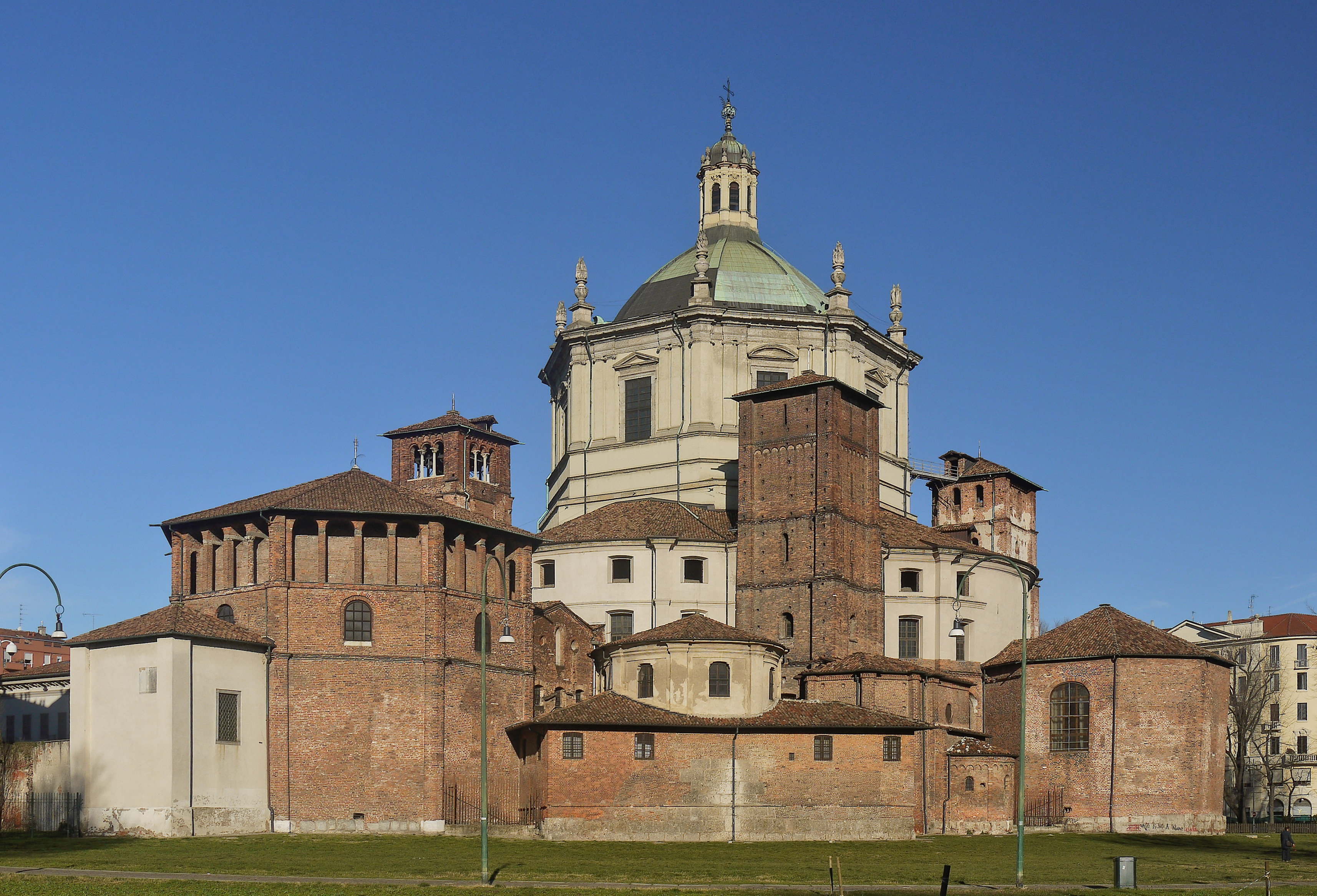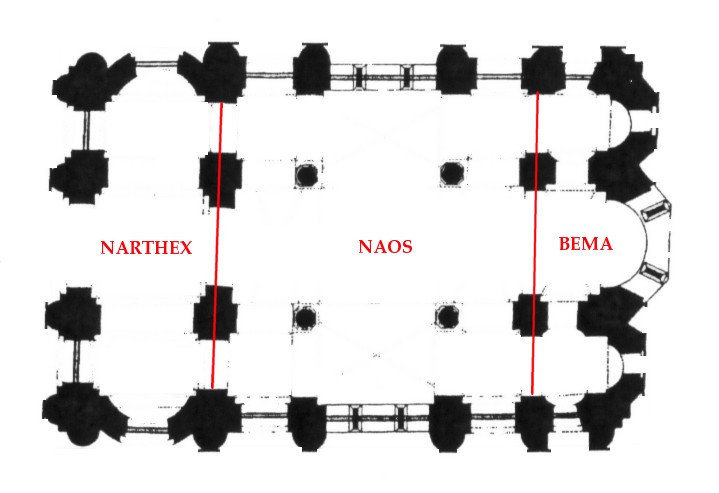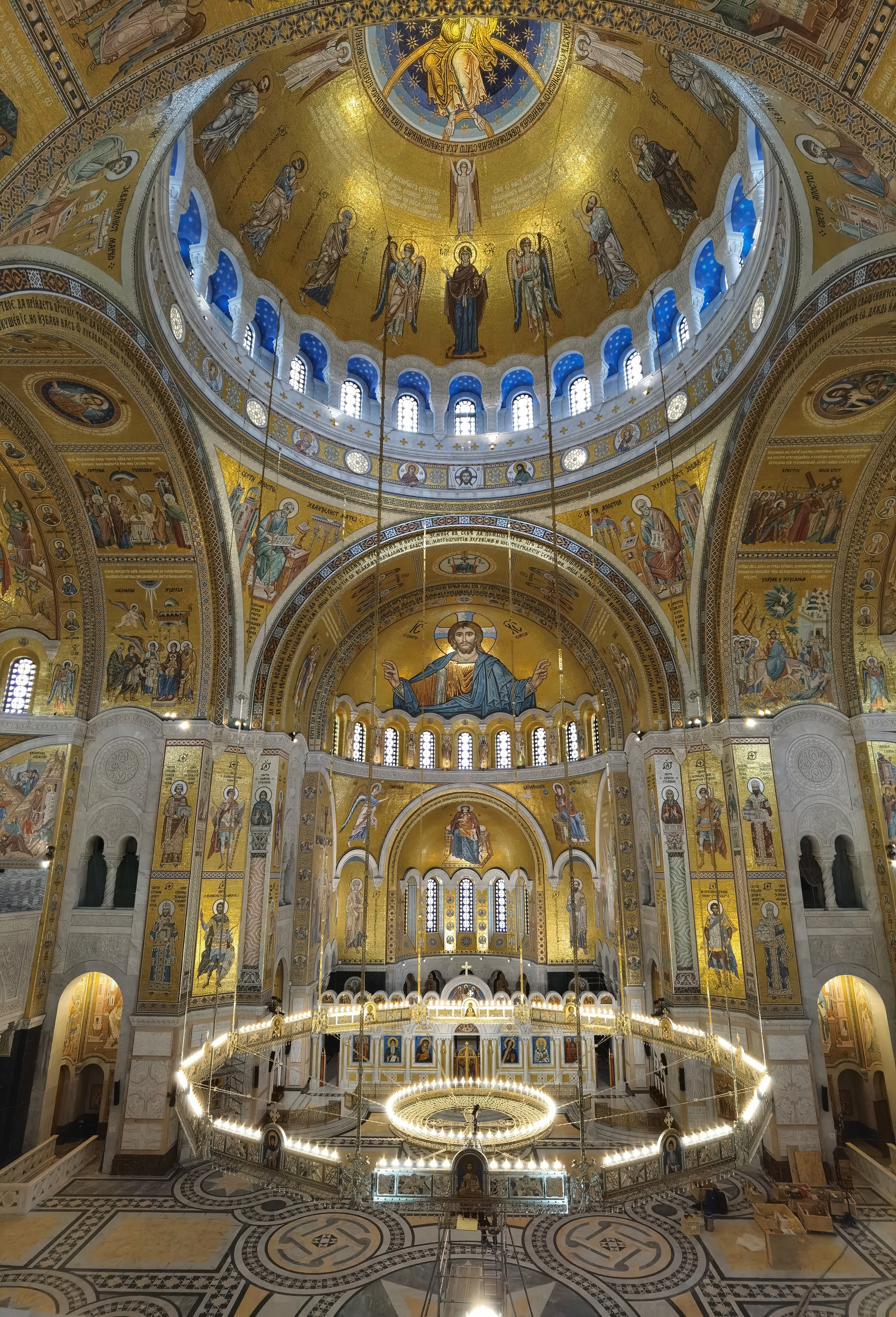|
Tetraconch
A tetraconch, from the Greek for "four shells", is a building, usually a church or other religious building, with four apses, one in each direction, usually of equal size. The basic ground plan of the building is therefore a Greek cross. They are most common in Byzantine, and related schools such as Armenian and Georgian architecture. It has been argued that they were developed in these areas or Syria, and the issue is a matter of contention between the two nations in the Caucasus. Apart from churches, the form is suitable for a mausoleum or baptistery. Normally, there will be a higher central dome over the central space. Overview The Basilica of San Lorenzo, Milan (370) is possibly the first example of a grander type, the "aisled tetraconch", with an outer ambulatory. In middle Byzantine architecture, the cross-in-square plan was developed, essentially filling out the tetraconch to form a square-ish exterior. Either of these types may also be described less precisely as ... [...More Info...] [...Related Items...] OR: [Wikipedia] [Google] [Baidu] |
Jvari (monastery)
:''The name of this monastery translated as the "Monastery of the Cross". For the Georgian monastery in Jerusalem with the same name, see Monastery of the Cross.'' Jvari Monastery () is a sixth-century Georgian Orthodox monastery near Mtskheta, eastern Georgia. Jvari is a rare case of an Early Medieval Georgian church that has survived to the present day almost unchanged. The church became the founder of its type, the Jvari type of church architecture, prevalent in Georgia and Armenia. Built atop of Jvari Mount (656 m a.s.l.), the monastery is an example of harmonious connection with the natural environment, characteristic to medieval Georgian architecture. Along with other historic structures of Mtskheta, the monastery was listed as a World Heritage Site by UNESCO in 1994. History Jvari Monastery stands on the rocky mountaintop at the confluence of the Mtkvari and Aragvi rivers, overlooking the town of Mtskheta, which was formerly the capital of the Kingdom of Iberia. ... [...More Info...] [...Related Items...] OR: [Wikipedia] [Google] [Baidu] |
Cross-in-square
A cross-in-square or crossed-dome plan was the dominant architectural form of middle- and late-period Byzantine churches. It featured a square centre with an internal structure shaped like a cross, topped by a dome. The first cross-in-square churches were probably built in the late 8th century, and the form has remained in use throughout the Orthodox world unto the present day. In the West, Donato Bramante's first design (1506) for St. Peter's Basilica was a centrally planned cross-in-square under a dome and four subsidiary domes. In German, such a church is a , or ‘cross-dome church’. In French, it is an , ‘church with an inscribed cross’. Architecture Architectural form A cross-in-square church is centered around a quadratic naos (the ‘square’) which is divided by four columns or piers into nine bays (divisions of space). The inner five divisions form the shape of a quincunx (the ‘cross’). The central bay is usually larger than the other eight, and is ... [...More Info...] [...Related Items...] OR: [Wikipedia] [Google] [Baidu] |
Cross-in-square
A cross-in-square or crossed-dome plan was the dominant architectural form of middle- and late-period Byzantine churches. It featured a square centre with an internal structure shaped like a cross, topped by a dome. The first cross-in-square churches were probably built in the late 8th century, and the form has remained in use throughout the Orthodox world unto the present day. In the West, Donato Bramante's first design (1506) for St. Peter's Basilica was a centrally planned cross-in-square under a dome and four subsidiary domes. In German, such a church is a , or ‘cross-dome church’. In French, it is an , ‘church with an inscribed cross’. Architecture Architectural form A cross-in-square church is centered around a quadratic naos (the ‘square’) which is divided by four columns or piers into nine bays (divisions of space). The inner five divisions form the shape of a quincunx (the ‘cross’). The central bay is usually larger than the other eight, and is ... [...More Info...] [...Related Items...] OR: [Wikipedia] [Google] [Baidu] |
Ambulatory
The ambulatory ( la, ambulatorium, ‘walking place’) is the covered passage around a cloister or the processional way around the east end of a cathedral or large church and behind the high altar. The first ambulatory was in France in the 11th century but by the 13th century ambulatories had been introduced in England and many English cathedrals were extended to provide an ambulatory. The same feature is often found in Indian architecture and Buddhist architecture generally, especially in older periods. Ritual circumambulation or parikrama around a stupa or cult image is important in Buddhism and Hinduism. Often the whole building was circumambulated, often many times. The Buddhist chaitya hall always allowed a path for this, and the Durga temple, Aihole (7th or 8th century) is a famous Hindu example. The term is also used to describe a garden feature in the grounds of a country house. A typical example is the one shown, which stands in the grounds of Horton Court in Glouces ... [...More Info...] [...Related Items...] OR: [Wikipedia] [Google] [Baidu] |
Narthex
The narthex is an architectural element typical of early Christian and Byzantine basilicas and churches consisting of the entrance or lobby area, located at the west end of the nave, opposite the church's main altar. Traditionally the narthex was a part of the church building, but was not considered part of the church proper. In early Christian churches the narthex was often divided into two distinct parts: an esonarthex (inner narthex) between the west wall and the body of the church proper, separated from the nave and aisles by a wall, arcade, colonnade, screen, or rail, and an external closed space, the exonarthex (outer narthex), a court in front of the church facade delimited on all sides by a colonnade as in the first St. Peter's Basilica in Rome or in the Basilica of Sant'Ambrogio in Milan. The exonarthex may have been either open or enclosed with a door leading to the outside, as in the Byzantine Chora Church. By extension, the narthex can also denote a cov ... [...More Info...] [...Related Items...] OR: [Wikipedia] [Google] [Baidu] |
Sankt Maria Im Kapitol (Flight Over Cologne)
St. Maria im Kapitol (St. Mary's in the Capitol) is an 11th-century Romanesque church located in the Kapitol-Viertel in the old town of Cologne, Germany. The name “im Kapitol“ refers to the Roman temple for the Capitoline Triad that was built on today’s site of the church in the first century. The Catholic church is based on the Church of the Nativity in Bethlehem, was dedicated to St. Mary and built between 1040 and 1065. It is one of twelve Romanesque churches built in Cologne during this period. Measuring 100 m x 40 m and encompassing 4,000 square metres of internal space, St. Maria is the largest of the Romanesque churches in Cologne. Like many of the latter, it has an east end which is trefoil in shape, with three apses. It has a nave and aisles and three towers to the west. It is considered the most important work of German church architecture of the Salian dynasty. History Late antiquity A temple to the Capitoline triad stood upon the small hill in the so ... [...More Info...] [...Related Items...] OR: [Wikipedia] [Google] [Baidu] |
Church Of Saint Sava
The Temple of Saint Sava ( sr-Cyrl, Храм Светог Саве, Hram Svetog Save, lit='The Temple of Saint Sava') is a Serbian Orthodox church which sits on the Vračar plateau in Belgrade, Serbia. It was planned as the bishopric seat and main cathedral of the Serbian Orthodox Church. The church is dedicated to Saint Sava, the founder of the Serbian Orthodox Church and an important figure in medieval Serbia. It is built on the presumed location of St. Sava's grave. His coffin had been moved from Mileševa Monastery to Belgrade. The coffin was placed on a pyre and burnt in 1595 by Ottoman Grand Vizier Sinan Pasha. Bogdan Nestorović and Aleksandar Deroko were finally chosen to be the architects in 1932 after a second revised competition in 1926–27 (for which no first award was granted, Nestorović being runner up). This sudden decision instigated an important debate in interwar Yugoslavia which centered around the temple's size, design and symbolic national function.Ale ... [...More Info...] [...Related Items...] OR: [Wikipedia] [Google] [Baidu] |
Armenia
Armenia (), , group=pron officially the Republic of Armenia,, is a landlocked country in the Armenian Highlands of Western Asia.The UNbr>classification of world regions places Armenia in Western Asia; the CIA World Factbook , , and ''Oxford Reference Online'' also place Armenia in Asia. It is a part of the Caucasus region; and is bordered by Turkey to the west, Georgia to the north, the Lachin corridor (under a Russian peacekeeping force) and Azerbaijan to the east, and Iran and the Azerbaijani exclave of Nakhchivan to the south. Yerevan is the capital, largest city and the financial center. Armenia is a unitary, multi-party, democratic nation-state with an ancient cultural heritage. The first Armenian state of Urartu was established in 860 BC, and by the 6th century BC it was replaced by the Satrapy of Armenia. The Kingdom of Armenia reached its height under Tigranes the Great in the 1st century BC and in the year 301 became the first state in the world to ... [...More Info...] [...Related Items...] OR: [Wikipedia] [Google] [Baidu] |
Basilica Of St
In Ancient Roman architecture, a basilica is a large public building with multiple functions, typically built alongside the town's forum. The basilica was in the Latin West equivalent to a stoa in the Greek East. The building gave its name to the architectural form of the basilica. Originally, a basilica was an ancient Roman public building, where courts were held, as well as serving other official and public functions. Basilicas are typically rectangular buildings with a central nave flanked by two or more longitudinal aisles, with the roof at two levels, being higher in the centre over the nave to admit a clerestory and lower over the side-aisles. An apse at one end, or less frequently at both ends or on the side, usually contained the raised tribunal occupied by the Roman magistrates. The basilica was centrally located in every Roman town, usually adjacent to the forum and often opposite a temple in imperial-era forums. Basilicas were also built in private residences ... [...More Info...] [...Related Items...] OR: [Wikipedia] [Google] [Baidu] |
Bramante
Donato Bramante ( , , ; 1444 – 11 April 1514), born as Donato di Pascuccio d'Antonio and also known as Bramante Lazzari, was an Italian architect and painter. He introduced Renaissance architecture to Milan and the High Renaissance style to Rome, where his plan for St. Peter's Basilica formed the basis of design executed by Michelangelo. His Tempietto ( San Pietro in Montorio) marked the beginning of the High Renaissance in Rome (1502) when Pope Julius II appointed him to build a sanctuary over the spot where Peter was martyred. Life Urbino Bramante was born under the name Donato d'Augnolo, Donato di Pascuccio d'Antonio, or Donato Pascuccio d'Antonio in Fermignano near Urbino. Here, in 1467, Luciano Laurana was adding to the Palazzo Ducale an arcaded courtyard and other Renaissance features to Federico da Montefeltro's ducal palace. Bramante's architecture has eclipsed his painting skills: he knew the painters Melozzo da Forlì and Piero della Francesca wel ... [...More Info...] [...Related Items...] OR: [Wikipedia] [Google] [Baidu] |
Mosaic
A mosaic is a pattern or image made of small regular or irregular pieces of colored stone, glass or ceramic, held in place by plaster/mortar, and covering a surface. Mosaics are often used as floor and wall decoration, and were particularly popular in the Ancient Rome, Ancient Roman world. Mosaic today includes not just murals and pavements, but also artwork, hobby crafts, and industrial and construction forms. Mosaics have a long history, starting in Mesopotamia in the 3rd millennium BC. Pebble mosaics were made in Tiryns in Mycenean civilisation, Mycenean Greece; mosaics with patterns and pictures became widespread in classical times, both in Ancient Greece and Ancient Rome. Early Christian basilicas from the 4th century onwards were decorated with wall and ceiling mosaics. Mosaic art flourished in the Byzantine Empire from the 6th to the 15th centuries; that tradition was adopted by the Norman dynasty, Norman Kingdom of Sicily in the 12th century, by the eastern-influenced R ... [...More Info...] [...Related Items...] OR: [Wikipedia] [Google] [Baidu] |
Ravenna
Ravenna ( , , also ; rgn, Ravèna) is the capital city of the Province of Ravenna, in the Emilia-Romagna region of Northern Italy. It was the capital city of the Western Roman Empire from 408 until its collapse in 476. It then served as the capital of the Ostrogothic Kingdom until it was re-conquered in 540 by the Byzantine Empire. Afterwards, the city formed the centre of the Byzantine Exarchate of Ravenna until the last exarch was executed by the Lombards in 751. Although it is an inland city, Ravenna is connected to the Adriatic Sea by the Candiano Canal. It is known for its well-preserved late Roman and Byzantine architecture, with eight buildings comprising the UNESCO World Heritage Site "Early Christian Monuments of Ravenna". History The origin of the name ''Ravenna'' is unclear. Some have speculated that "Ravenna" is related to "Rasenna" (or "Rasna"), the term that the Etruscans used for themselves, but there is no agreement on this point. Ancient era The origins ... [...More Info...] [...Related Items...] OR: [Wikipedia] [Google] [Baidu] |










.png)